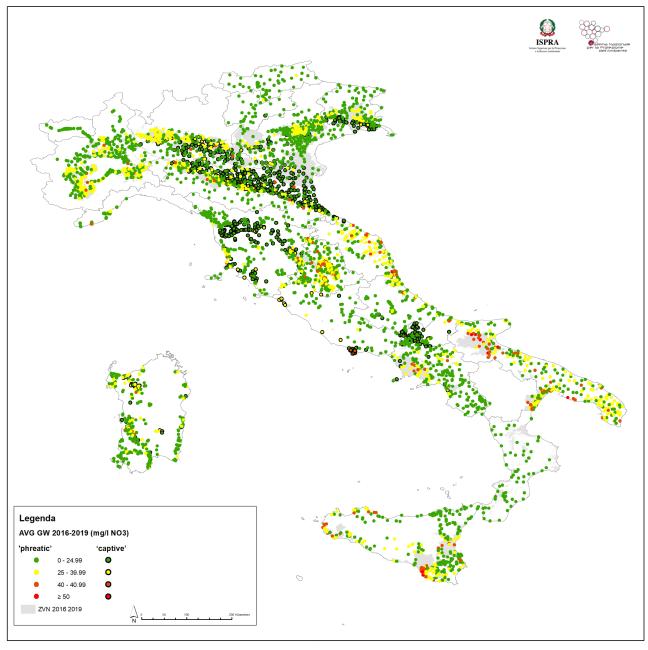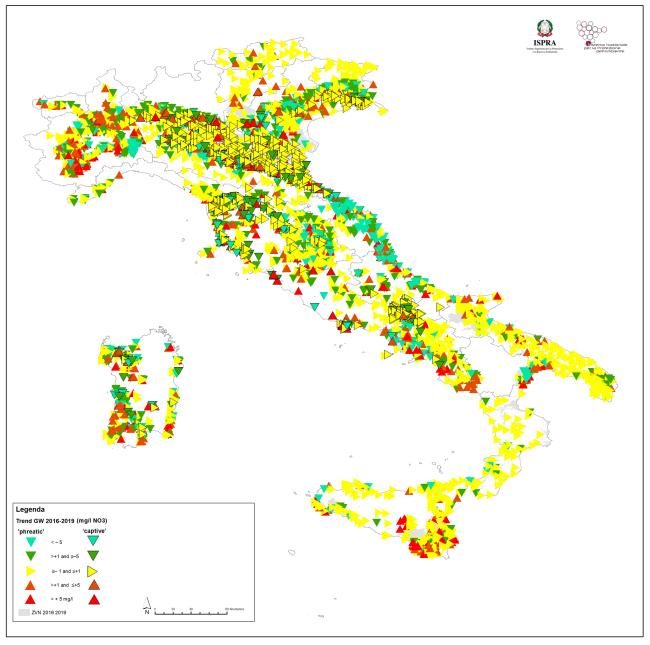Panel 1
Giordano Giorgi, Marilena Insolvibile, Massimo Peleggi, Silvana Salvati
The indicator provides the percentage of groundwater monitoring stations divided into quality classes based on the average nitrate concentration recorded over a four-year monitoring period (2016–2019). Specifically:
- 68.1% of stations show an average nitrate concentration below 25 mg/L,
- Only 12.6% of monitored points recorded an average concentration equal to or above 50 mg/L.
Additionally, an analysis comparing the trend over the last four years (2016–2019) to the previous four years (2012–2015) reveals predominantly stable nitrate concentrations, a decrease in average concentration at 37.9% of common stations between the two periods, and an increase at only 22.7% of the same stations.
Nitrate monitoring in groundwater is conducted under the Nitrates Directive (Directive 91/676/EEC), which aims to protect waters from pollution caused or induced by agricultural nitrates. For groundwater, the threshold value for nitrate concentration is 50 mg/L.
The quality classes are as follows (from worst to best):
- ≥ 50 mg/L - Red
- Between 40 and 49.99 mg/L - Orange
- Between 25 and 39.99 mg/L - Yellow
- Between 0 and 24.99 mg/L - Green
The quality classes for trends are as follows (from worst to best):
- Strong increase: > 5 mg/L - Red
- Mild increase: +1 to 5 mg/L - Orange
- Stable: -1 to +1 mg/L - Yellow
- Mild decrease: -5 to -1 mg/L - Green
- Strong decrease: < -5 mg/L - Blue
For each concentration and trend quality class, the percentage of groundwater monitoring sites falling into that class is provided.
Monitoring aims to identify polluted or at-risk waters, designate vulnerable zones (areas where nitrate pressures make them particularly sensitive and prone to pollution if not addressed), define Action Programs (a series of measures to prevent and reduce nitrate pollution), and, ultimately, develop Codes of Good Agricultural Practice that establish a set of good practices.
To evaluate, over the medium to long term, the impact of human activities related to nitrate inputs into groundwater. These activities include the use of fertilizers for agricultural crops, the presence of livestock—particularly intensive farming—and untreated wastewater that percolates into groundwater.
- Nitrates Directive 91/676/EEC – Article 10
- Directive 2000/60/EC
- Legislative Decree No. 152/2006
- Legislative Decree No. 30/2009
- Ministerial Decree of July 6, 2016
Reference threshold for nitrate concentration in groundwater: 50 mg/L
Panel 2
Relazione ex articolo 10 della Direttiva 91/676/CEE ITALIA - Quadriennio 2016-2019 Sito web Commissione europea su Direttiva nitrati: https://environment.ec.europa.eu/topics/water/nitrates_en Report from the commission to the council and the European Parlament on the implementation of Council Directive 91/676/EEC concerning the protection of waters against pollution caused by nitrates from agricultural sources based on Member State reports for the period 2016–2019 – https://eur-lex.europa.eu/legal-content/EN/TXT/?uri=COM%3A2021%3A1000%3AFIN&qid=1633953687154
Data quality assessment
SINTAI
SINTAI - https://www.sintai.isprambiente.it - Sezione Direttiva 91/676 > Accesso dati reporting Nitrati
National, Regional
2008-2019
Indicator assessment
The percentage of groundwater monitoring sites is calculated relative to the total number of sites falling within quality classes, which are identified by nitrate concentration intervals and the variation intervals of nitrate concentrations between the average values of the current four-year period (2016–2019) and the previous four-year period (2012–2015).
Regarding groundwater, the results of the distribution of monitoring stations across different quality classes (0–24.99 mg/L, 25–39.99 mg/L, 40–49.99 mg/L, and ≥50 mg/L) show that out of 4,612 sampling points for the 2016–2019 period:
- 68.1% of the stations had an average nitrate concentration below 25 mg/L,
- Only 12.6% of the monitored points recorded an average concentration equal to or above 50 mg/L (Table 2, Figure 1).
From the analysis of trends between the previous four-year period (2012–2015) and the current period (2016–2019), it was found that the average nitrate concentration decreased in 37.9% of the 3,431 common stations between the two periods, while an increase was recorded in only 22.7% of the same stations. A stable trend prevails, observed in 39.4% of the stations (Table 3, Figure 2).
Data
Table 1: Network monitoring nitrate groundwater
ISPRA elaboration on SINTAI data - Directive 91/676 four-year-olds 2012-2015, 2016-2019
Table 2: Distribution of monitoring stations in different quality classes
ISPRA processing on data SINTAI Directive 91/676 four-year period 2016-2019
Table 3: Trend of the average nitti concentration four-year-olds 2016-2019, 2012-2015
ISPRA processing on data SINTAI Directive 91/676


Within the regional nitrate network, ARPA/APPA conducts nitrate concentration monitoring at groundwater and surface water sampling stations affected by agricultural pressures and forwards the data to ISPRA. Every four years, ISPRA submits a report to the European Commission on the implementation status of the Nitrates Directive (Directive 91/676/EEC) across the national territory.
For the 2016–2019 period, the number of stations ranged from a maximum of 581 in Umbria to a minimum of 30 in the province of Trento, totaling 4,612 stations (Table 2). Emilia-Romagna had the highest number of stations with an average concentration of <25 mg/L NO3 (368), while Umbria recorded the highest number of stations with an average concentration of ≥50 mg/L NO3 (Table 1, Figure 1). All stations in the ≥50 mg/L NO3 class are subject to requirements defined by the Nitrates Directive.
Based on nitrate concentrations due to agricultural pressures, Nitrate Vulnerable Zones (ZVN) are designated as particularly sensitive areas at risk of pollution without intervention. Control programs and actions to prevent and reduce nitrate pollution are then identified (Figure 1).
Over the last two four-year periods, the Nitrates Directive monitoring network underwent revision due to various factors such as changes in the significance of agricultural pressures and sampling feasibility. As a result, the number of stations decreased from 5,035 in 2012–2015 to 4,612 in 2016–2019, with 3,431 common sampling points (Table 1).
A significant increase in nitrate concentration (>5 mg/L) was observed in 14.6% of stations in Basilicata compared to the previous period, while a significant decrease (<-5 mg/L) was noted in 87.1% of stations in Calabria. These variations are also influenced by the number of stations identified for monitoring (48 in Basilicata and 85 in Calabria) (Table 3, Figure 2).
In general, it can be stated that most monitored aquifers are characterized by a stationary or improving situation concerning nitrate contamination.